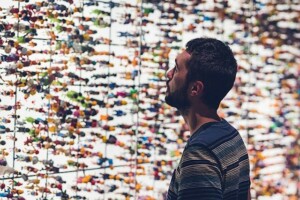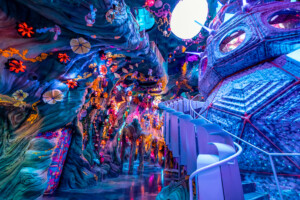‘I want SEA LIFE to be the Google of the marine world”, says James Burleigh, the new chief ambassador of Merlin Entertainments’ SEA LIFE aquarium network.
No small ambition for the man tasked with being the brand’s ‘heart and conscience’, ensuring welfare and marine conservation are always at its core.
%20(2).jpg) Burleigh (left) spoke to Blooloop about the path that brought him to a role that is clearly a vocation rather than a job and his vision for SEA LIFE both now and in the future.
Burleigh (left) spoke to Blooloop about the path that brought him to a role that is clearly a vocation rather than a job and his vision for SEA LIFE both now and in the future.
Dipping a Toe in the Water
This is Burleigh’s 23rd year with Merlin, which he joined when it was Vardon PLC, the holding company for two Dungeons and six SEA LIFE centres, and later for bingo, holiday parks and health and fitness divisions.
“Our Chief Exec’ Nick Varney led a management buyout of the attractions bit of Vardon in 1999 and Merlin was born, ” said James.
Burleigh’s original role was as Head of Procurement for Vardon:
“My biggest challenge was synchronising purchasing to best advantage across the separate divisions, but I was also responsible for everything from doing deals for chickens for Bingo clubs (seriously) to buying fridges, and it was the latter sort of duties that led me to question whether this was really for me.”
When it was suggested to him, by the team who founded SEA LIFE in 1979, that he would make a great manager in a SEA LIFE centre, he sat down with the then Chief Executive of Vardon PLC, Nicholas Irens.
“He thought I’d be more interested in a management role in the bingo division, but when I told him I really wanted to try my hand at the helm of a SEA LIFE centre he offered every encouragement.”
.jpg)
A Ditzy Aquarium on a Pier
Burleigh moved out of London with his family, to a small village, Hutton, near Weston Super Mare, opening the SEA LIFE centre in Weston Super Mare under his general management in 1995.
“It was a sideways move, but I fell in love with the business, fell in love with what an aquarium stood for. Although it was quite a small, ditzy aquarium on the pier, it was great.
The doors had been open barely three months when Nick Varney told him about ambitious plans to transform the much older Weymouth SEA LIFE Centre into a Park, with a combination of indoor and outdoor attractions making it more of an all-day visit rather than a place to spend an absorbing couple of hours.
“So I was seduced into covering both Weymouth and Weston for a period, but eventually was able to hand over the latter to a new GM and put a new management team together in Weymouth, moving the family once more.
.jpg)
(Above: Midway Developments team)
“I really loved it. I loved the day-to-day involvement in a vibrant, constantly changing attraction and in particular the challenge of making sure that visitors went away with smiles on their faces.”
However, he also wanted to progress, and after five years accepted the central role of Commercial Director for Merlin.
“We were opening SEA LIFE centres in Germany; we were opening Dungeons and we were on the alert for potential acquisitions.”
.jpg)
It was now that Burleigh had a chance to hone his ambassadorial skills to help propel Merlin from being a small and ambitious, essentially Euro-centric company, to the global phenomenon it was to become.
Cementing Key Partnerships
“I was involved in helping cement a host of key partnerships – Coke, Nestle and so on.
.jpg) Part of my role was to sell the story of where Merlin was going, predominantly around SEA LIFE and the bits that I knew well, to convince these big hitters it was worth coming with us, even though at that stage we were comparative minnows.
Part of my role was to sell the story of where Merlin was going, predominantly around SEA LIFE and the bits that I knew well, to convince these big hitters it was worth coming with us, even though at that stage we were comparative minnows.
Merlin’s and James’s confidence was not misplaced however. In November 2013 Merlin floated 30% of the company on the London Stock Exchange valuing the private equity-backed company at almost £3.4 bn.
Expansion gathered pace with the acquisitions first of the LEGOLAND theme parks and then – most significantly – of the Tussauds group.
“In around 2007 I became the divisional director, reporting to Glenn Earlam, the divisional director for SEA LIFE, a role which took in all the European SEA LIFE centres that we had at the time, and was, effectively, a separate company within the company.”
The growth continued, and with its expansion into new countries…new continents…came many new challenges, not least those presented by often widely divergent cultures.
“It was my job to effectively negotiate those challenges when I became Midway Europe’s divisional director, overseeing the operations of SEA LIFE centres, Madam Tussauds, Dungeons and the emerging LEGOLAND Discovery Centre brand and any other attractions and VCs that we were opening, or integrating into our business model, ” says Burleigh.
That role changed in 2012 when he became the divisional director for new developments.
“I then oversaw the opening of our Midway attractions all over the world through the New Openings team. I’d be in Bejing, opening a new Madame Tussauds one day and the next day opening a new SEA LIFE centre somewhere in the States. It was exhausting.”
After three and a half years of constant travelling, Burleigh had to make the decision either to stay in the role, committing to another three or four years with the newly formed New Openings team, or to opt for a complete change.
Fully Immersed in the SEA LIFE Brand
“So Nick Varney told me he had a new ‘ambassadorial’ role with what he rightly guessed was my favourite brand – SEA LIFE – to offer me, and I jumped at it.”
The world of aquaria is, Burleigh says, changing rapidly.
“People expect serious tangible conservation work to be an integral factor. It’s not a sales pitch. You can’t sell conservation.
“As well as expecting us to take the best possible care of our animals, they want to be inspired and excited. We need to achieve that in a way that makes sure people leave having learned something that inspires them to care more about the marine world.”
.jpg)
“For some it might result in them taking getting involved in a conservation project, ” says Burleigh. “For others it may lead to a change of behaviour, like refusing to eat any fish that is not from a sustainable source, or spurning plastic bags.
“Visiting attractions and visiting aquaria used to be a bit like a one-night stand. What we’ve got now is a much more end to end relationship with the consumer – because our technologies have improved, we can talk to our guests in different ways at different times of the day and year, and at different times during their visit. So it’s much more immersive.”
Within the PLC environment, profit is important and a big part of the job. Burleigh’s role as ‘conscience’ is, however, of equal importance.
%20(600x400).jpg)
“It’s like a set of scales with thrills, excitement, escapism and good value, good quality leisure time on the one side and saving our seas and sea creatures on the other. I’m the one in the middle doing my best to keep both sides perfectly balanced.
“I have to be the voice of reason when, for arguments sake, we want to invest in our penguin enclosure in London and there are dissenters arguing that we shouldn’t have penguins there at all.
“If the natural world, including the Antarctic, was much better cared for and in much better shape than it is, then they might have a point. In reality however, displays like the one in London are critical to help inform people of the problems facing the natural environment and engaging their support to do something about it.
 For Burleigh, the SEA LIFE brand is encapsulated by an incident with his own children on a beach in Cornwall.
For Burleigh, the SEA LIFE brand is encapsulated by an incident with his own children on a beach in Cornwall.
“One day I took them to the beach down in Cornwall, – at the time we had three, and the youngest was quite wee but the other two were five and six. The tide had gone out and they went trundling off to a rock pool. And this other family came up, and their kids clearly hadn’t got a clue; they didn’t know what to look for, they didn’t know what they were doing. And my kids got stuck down into this, and showed them how to pick up the starfish and how to touch the crabs, what to do – don’t take the starfish out of the water: that’s dangerous.
“They made friends for about twenty minutes, then moved on. And they’d taught the other kids how to be appropriate with the animals and I just thought, that’s a really defining moment for me: we take for granted that we’ve got animal welfare par excellence with the people who work for us and who care so much, but show people the animals in the right way and be able to educate people, on how valuable they are on a very small scale… that encounter with a rock pool sort of defines SEA LIFE.
“Whilst being the conscience of the brand, I will protect to my utmost the things that I believe we stood for 15-20 years ago.”
.jpg)
Marine Biologists First – Entrepreneurs Second
“SEA LIFE’s founders were passionate marine biologists first…entrepreneurs second. They had discovered and fallen in love with a world that is inaccessible to most, and they wanted to share their discovery with as many people as possible.
“If you work for LEGO or LEGOland a visit to Denmark to see the house where the Christiansen family first invented those famous bricks is a compulsory part of your induction.
“Knowing about the roots of the SEA LIFE brand and the values it established from that first day when the first centre opened in Oban in the West Highlands, should also be obligatory.
“Merlin has many other attraction brands however, and inevitably there is significant migration of staff between them. It’s my job to ensure no-one moves to a SEA LIFE centre without any knowledge of the brand’s history and heritage and without knowing that preserving that legacy is every bit as important as making money.
“Indeed if we fail to do the former, we’ll very soon find that we’re not doing the latter either.”
.jpg)
Staff Engagement = Consumer Engagement
However, Burleigh points out that understanding and recognising the heritage of a brand can be challenging when opening a SEA LIFE centre in a shopping mall in South Carolina, two or three hours away from the sea.
“You’ve got to have that engagement with your team, so they can engage with the guest. So I spend a lot of time getting on my hobby horse insisting that the people who are working for us go through the proper induction, where no-one gets to talk to even a guest until they’ve understood what it is to be a SEA LIFE General Manager: having an empathy with the curators who work with the animals, with the staff on the front line. There’s a whole piece of work in my role around talking to the public, around how these animals are presented.”
The SEA LIFE brand team is working hard at ensuring that people know the difference between visiting a SEA LIFE venue, and any other aquarium.
.jpg)
“There are certain key principles around what we stand for: what we campaign for and what we actually display are a part of that, but there is also that whole positioning around the rock pool and the matter of being a bit of a passionate campaigner for the seas, and, represented by the ambassadors, for the creatures themselves.”
SEA LIFE, he says, feels more intimate than giant aquaria which showcase everything from whale sharks and belugas to manta rays.
“And that brings us to the next subject, ” says Burleigh, “which is – what do you do when you acquire an aquarium through the PLC-world, and it happens to have belugas in it?”
.jpg)
Changfeng Ocean World
This is what happened in Shanghai, when SEA LIFE acquired Changfeng Ocean World in 2012 as part of an acquisition of the larger Living and Leisure Group in Australia.
“As part of that there were three beluga whales in a stadium that had been built for them where 2000 school kids a day would come through and scream and shout and watch these animals do tricks – painting, and various other things. That jarred, clearly, with our remit and also with our belief that the best place for cetaceans – whales and dolphins – isn’t actually in aquaria and we wouldn’t ever want them by any other means except by accident, and that includes the Changfeng acquisition, which incidentally was just one attraction in a portfolio comprising several others.
“Since before I began in my current role the team here has been working tirelessly to find a solution, and that solution, we believe, is to develop a sanctuary in the sea.”
.jpg)
“We’ve got further than practically anyone before us in that we’ve found a location. Not only that, we have worked out and costed the special facilities it will need and what will be required to transport the three whales there while doing everything that can feasibly be done at every stage to safeguard their health and welfare.
“The world will be watching. We are under no illusions on that score. The whole mission will be televised – probably globally. There will be tension and drama and it could go badly in spite of every precaution. We are determined to press ahead nonetheless, because it is the right thing to do.
Developing A Watertight Environmental Policy
One aspiration of Burleigh’s is that SEA LIFE should be completely environmentally friendly:
“…more so than any aquaria ever, ” he said. “Everything from the food, the consumables that you wipe your mouth and stir your coffee with, the decking you sit on overlooking the lake – every element should be sustainably sourced and environmentally friendly.”
Germany is very much in the vanguard, from an ecological perspective.
.jpg)
SEA LIFE has eight centres in Germany. When they were under construction SEA LIFE was partnering with Greenpeace, and each centre boasted a 100 square metre Greenpeace exhibition room.
“And they would help us build environmentally friendly SEA LIFE centres.
“I remember in one of the centres, on Lake Constance I think, 200 m² of decking had to be taken up and replaced because it was not from a sustainable source. That’s how committed we were and we should be.”
“SEA LIFE is a great brand, and has, like all of the Merlin portfolio, grown very fast. My role is making sure that people don’t forget where we came from, and that we’re doing the right thing.”
With an organisation as large and widespread as SEA LIFE, it can take a little time to ‘do the right thing.’
.jpg)
“At a single venue things are a lot simpler, which is how The Eden Project for example, manages to guarantee that everything you touch or buy while you’re there is environmentally friendly and sustainably produced.
“We’re in so many different countries now, and have grown so fast, that it’s impossible to offer any such guarantees with absolute assurance.
“What we can do though is set a realistic deadline for achieving the squeaky cleanliness that we aspire to, and so long as people can see we’re making a genuine effort and real progress, they trust that.
“Everywhere you go these days there is more information and more contention, and I think it comes down to whether people trust you as a brand.
Conservation in Action
On the subject of the future of the oceans, Burleigh is a pragmatist.
“Nothing is impossible, ” he says. “I’ve got the force of my company behind me, so we can change things and make a difference.”
.jpg)
“We sent a group over to an island off the Maldives last year, where the reefs have been destroyed by a combination of global warming and destructive fishing practices.
“Instead of preaching a ‘stop fishing’ message, they set about helping to restore coral reef to what has long since been reduced to barren sandy seabed.
“In no time at all, the specially designed coral frames that they put in place attract fish and larvae, and the regeneration begins.
“That’s a very compelling story to tell our 25 million-plus visitors, and one they will want to pass on.”
.jpg)
A Board of Conscience
“We have to make a change. We’re not there just to show fish off. We’re there to serve a purpose.”
Burleigh contends that as his role evolves, other roles like his will be established, leading to the formation of a board of conscience, which will include other people within Merlin.
“So then you stretch it within Merlin to other reaches, theme parks, and to other parts of the company, and, of course, the cultures are very different around the world. We’ve got a lot of work to do and probably another ten years, for example, before China sees the world like the Germans do.”
The SEA LIFE Trust
“Aquaria are progressing a bit like zoos have done. The really good zoos now do a fantastic job. You go to Chessington, for instance, knowing unconditionally there is conservation work going on, and there’s got to be that same connection with the guests that come to an aquarium.
.jpg) “The reality is that we’ve been championing the natural marine environment for decades, but the fact that we are also a commercial enterprise quite naturally inspires a degree of cynicism…the belief that we’re only doing these things to achieve respectability for our business.
“The reality is that we’ve been championing the natural marine environment for decades, but the fact that we are also a commercial enterprise quite naturally inspires a degree of cynicism…the belief that we’re only doing these things to achieve respectability for our business.
“That’s why we instigated the creation of a separate registered charity The SEA LIFE Trust, the constitution of which gives it independence from SEA LIFE in terms of where it directs its funds, but which SEA LIFE supports by raising cash for it and by providing a platform for it to communicate its goals and achievements to that 25-milllion plus annual visitors.
“Everybody is fighting for the same things in the NGO world, but everybody is doing it in a slightly different way.
“Some fail dismally to translate for a lay audience what can often be complex scientific objectives and hence fail to attract popular support, while others simply don’t have the necessary reach.
“The Sea Life Trust is fortunate indeed to have ready access to such a substantial audience of potential advocates and supporters.
“It’s small wonder that other NGOs are desperate to collaborate with the Trust.”
.jpg)
Why Children Matter Most
SEA LIFE’s most important visitors are children, says Burleigh, and no effort is spared in ensuring that their experience is as inspirational as it can be.
“Children are the future guardians of our planet, including our oceans of course, ” he says, “so we want to impress them at the earliest possible juncture with the responsibility, but also the privilege, that this entails.
“The best way to capture their imaginations is not to talk directly about the different environments each key species inhabits, but to lead with the creatures and gradually bring in all the factors that are important to their survival, including their preferred environment.
“So if we’re talking about seahorses we don’t talk to them about the percentage of eel grass that needs to be restored in a bay off Studland in order for them to breed: we talk about the seahorse and its home, in language that gets them engaged with what we do.”
%20(2).jpg) The Google of the Marine World
The Google of the Marine World
Children are key. While it is the parents who might make the decision to visit, it is the children who will return home having learned more, who will challenge more, and, in many cases, be more aware.
“A child of 5-10 walking around a SEA LIFE centre will have completely different views and reasons for being there from their parents.” says Burleigh.
“Yes, they want to be wowed and see amazing displays, and we have to keep up with all the latest technology, something Merlin gives us, but the actual take out will be that they will learn why those animals are here, where they have come from, whether they have been captive-bred or are wild caught from an ethical source.
“ Our objective is to make them want to learn more after their visit, and we know we succeed in that because that’s how many of our current aquarists first got interested in marine life.
“Up until now, we have maybe spent too much time defending our attractions and activities in the face of a tiny by vociferous animal rights lobby, and not enough time shouting about all the great work we do.
“That’s another area I am addressing… making sure that we trumpet our successes from the turtle releases in Australia to breeding a second generation of weedy sea dragons in Korea, which is the most amazing achievement.
“People will then start to see us in an even more positive light. I want SEA LIFE to be the Google of the marine world. If a child comes home from school and wants to learn something about the oceans or marine life, or they’ve heard something that day about a washed-up whale, they’ll be able to type ‘what does SEA LIFE think.com’ or something similar, and be able to get an answer or chat to somebody who can help them with it.
“And, that’s what I mean about it not just being about the four walls and a roof, it’s about the whole end-to-end of being with a family or with a child for their life, and being the guardian of what we’re doing.”
Images kind courtesy Merlin Entertainments















